Assignment The Nurse Leader as Knowledge Worker
The term knowledge worker was first coined by management consultant and author Peter Drucker in his book
The term knowledge worker was first coined by management consultant and author Peter Drucker in his book, The Landmarks of Tomorrow (1959). Drucker defined knowledge workers as high-level workers who apply theoretical and analytical knowledge, acquired through formal training, to develop products and services. Does this sound familiar?
Nurses are very much knowledge workers. What has changed since Drucker’s time are the ways that knowledge can be acquired. The volume of data that can now be generated and the tools used to access this data have evolved significantly in recent years and helped healthcare professionals (among many others) to assume the role of knowledge worker in new and powerful ways.
In this Assignment you will consider the evolving role of the nurse leader and how this evolution has led nurse leaders to assume the role of knowledge worker. You will prepare a PowerPoint presentation with an infographic (graphic that visually represents information, data, or knowledge. Infographics are intended to present information quickly and clearly.) to educate others on the role of nurse as knowledge worker.
Reference: Drucker, P. (1959). The landmarks of tomorrow. New York, NY: HarperCollins Publishers.
To Prepare:
- Review the concepts of informatics as presented in the Resources.
- Reflect on the role of a nurse leader as a knowledge worker.
- Consider how knowledge may be informed by data that is collected/accessed.
The Assignment:
- Explain the concept of a knowledge worker.
- Define and explain nursing informatics and highlight the role of a nurse leader as a knowledge worker.
- Include one slide that visually represents the role of a nurse leader as knowledge worker.
- Your PowerPoint should Include the hypothetical scenario you originally shared in the Discussion Forum. Include your examination of the data that you could use, how the data might be accessed/collected, and what knowledge might be derived from that data. Be sure to incorporate feedback received from your colleagues’ responses.
Scenario: Reducing Medication Administration Errors
Medication administration errors are a significant concern in healthcare, posing risks to patient safety and leading to adverse outcomes. In a hypothetical 21-bed medical-surgical unit with an average daily census of 18 patients, the unit has observed an increase in medication errors over three months. These errors range from incorrect dosages to missed medications, with patterns suggesting that certain shifts, staff members, or high-acuity patient loads may contribute to the problem. Addressing this issue requires a systematic, data-driven approach to identify root causes and implement effective solutions.
Expert Answer and Explanation
Nurse Leader As a Knowledge Worker
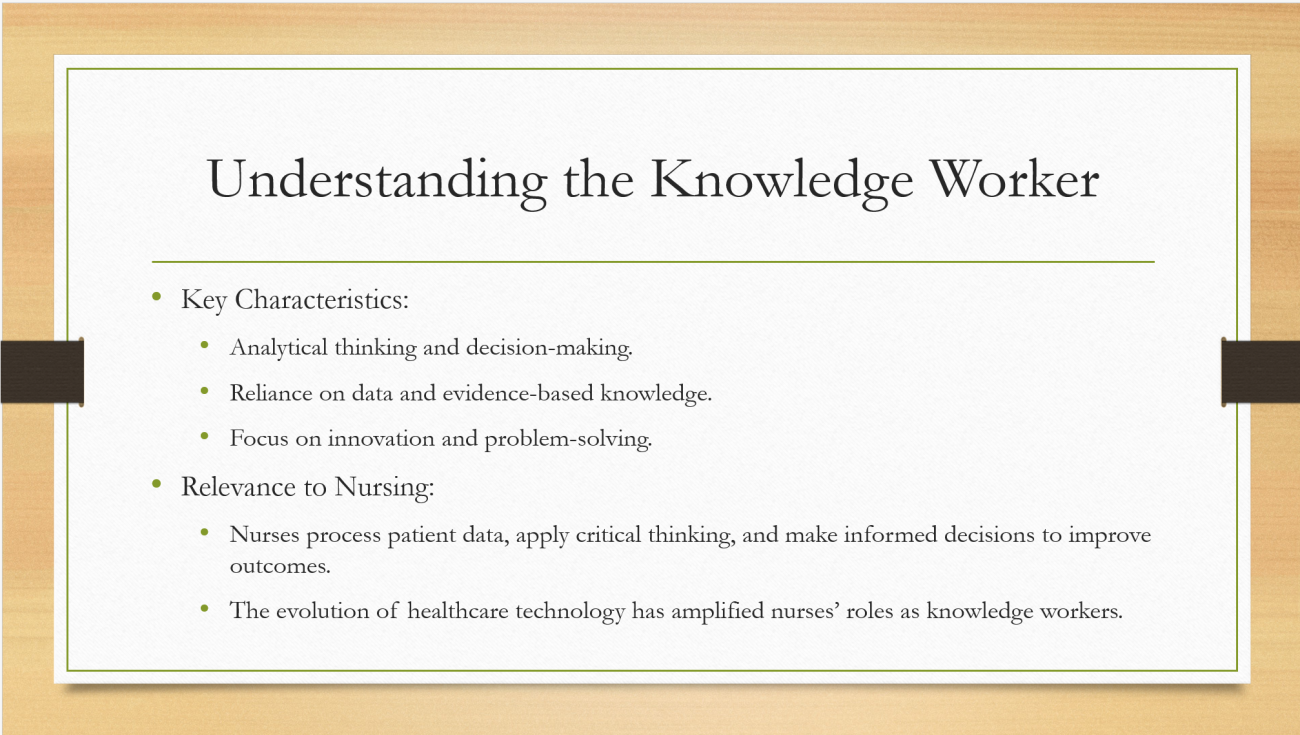
A knowledge worker is a professional who uses theoretical and analytical knowledge acquired through formal education to innovate, solve problems, and improve processes. In nursing, this role is evident as nurses routinely analyze data and apply critical thinking to make informed decisions for patient care. With the advancement of healthcare technology, the nurse’s role as a knowledge worker has expanded, enabling them to utilize sophisticated tools and systems to process information, implement evidence-based practices, and foster improvements in patient outcomes (Khaksar et al., 2023).
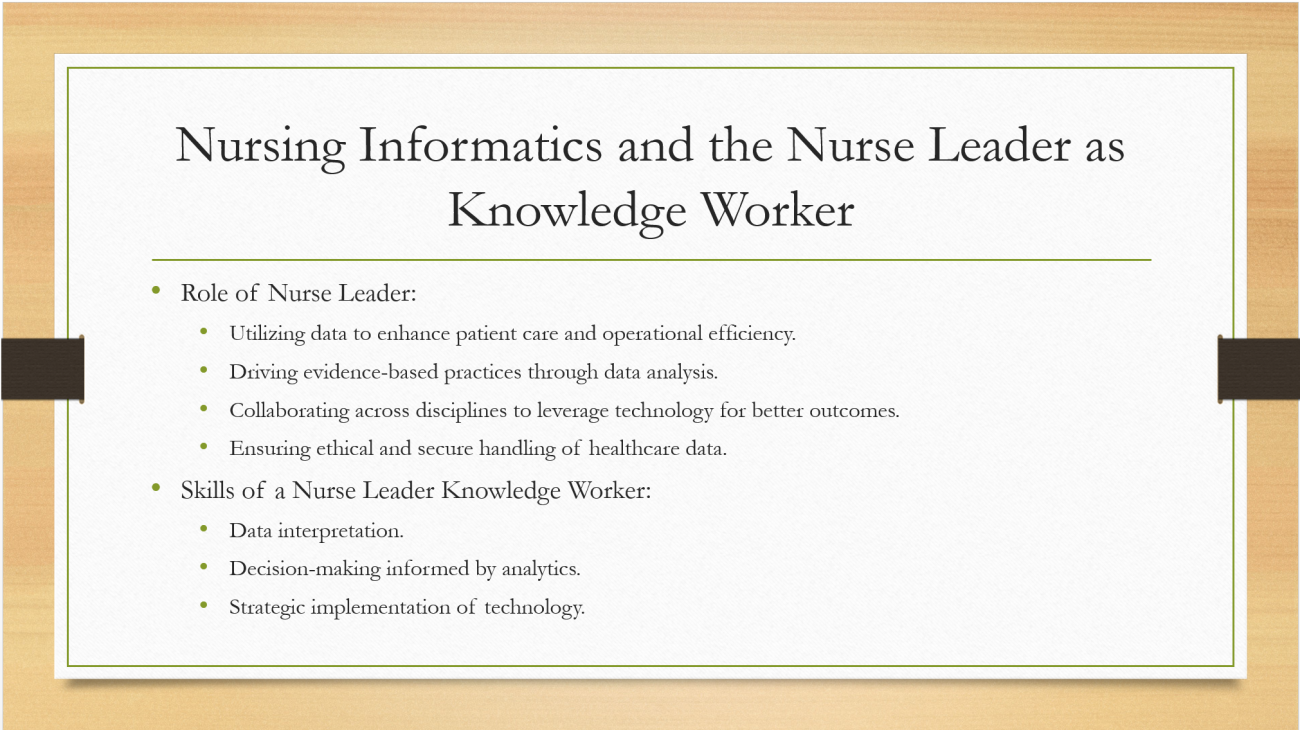
Nursing informatics merges nursing science with information technology to optimize the management and communication of healthcare data. Nurse leaders leverage informatics to analyze data, develop evidence-based strategies, and collaborate across disciplines. Their role includes interpreting data trends, implementing quality improvement measures, and using technology to improve patient care delivery (Khaksar et al., 2023). Essential skills for nurse leaders as knowledge workers include data analysis, decision-making based on analytics, and the strategic application of technology to enhance both clinical and operational outcomes.
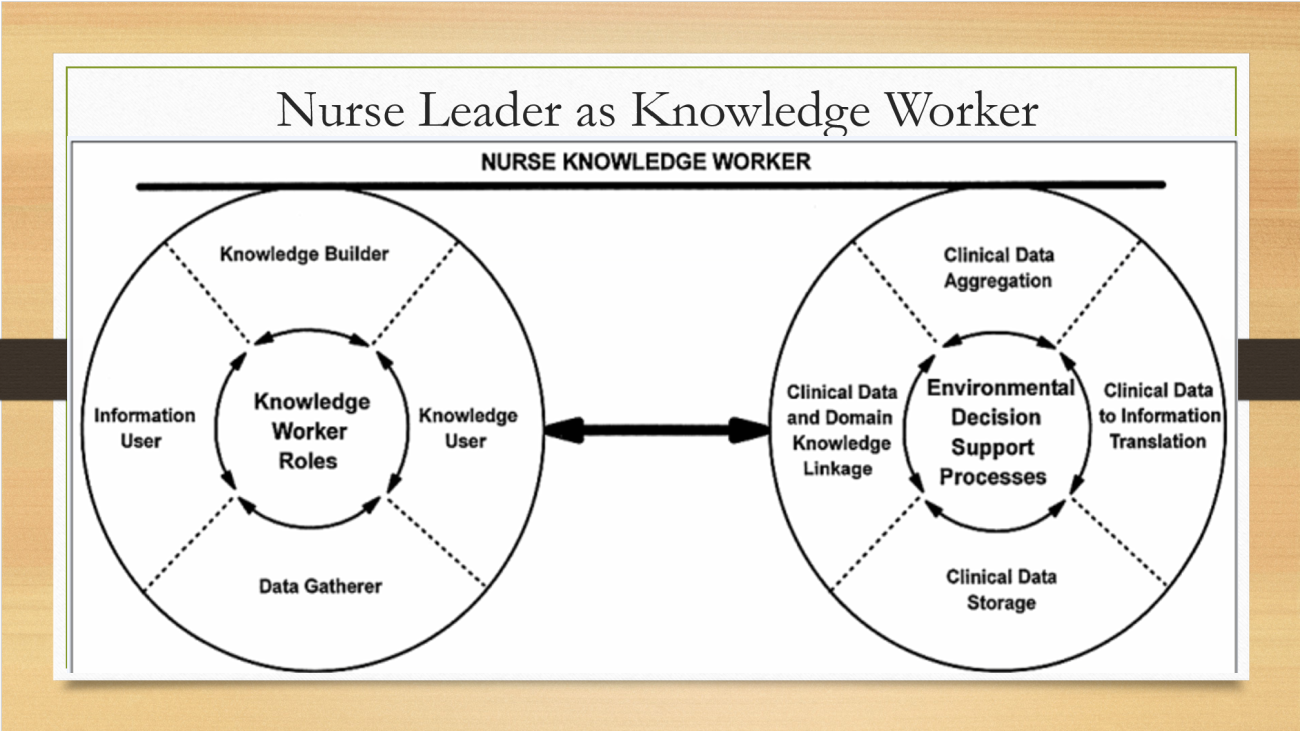
The infographic illustrates the multifaceted role of nurse leaders as knowledge workers. It highlights the process of data collection from patient health records and feedback, followed by data analysis to identify trends and gaps in care. Nurse leaders then apply this knowledge to implement policy changes, improve clinical practices, and enhance staff training (Cummings et al., 2021).
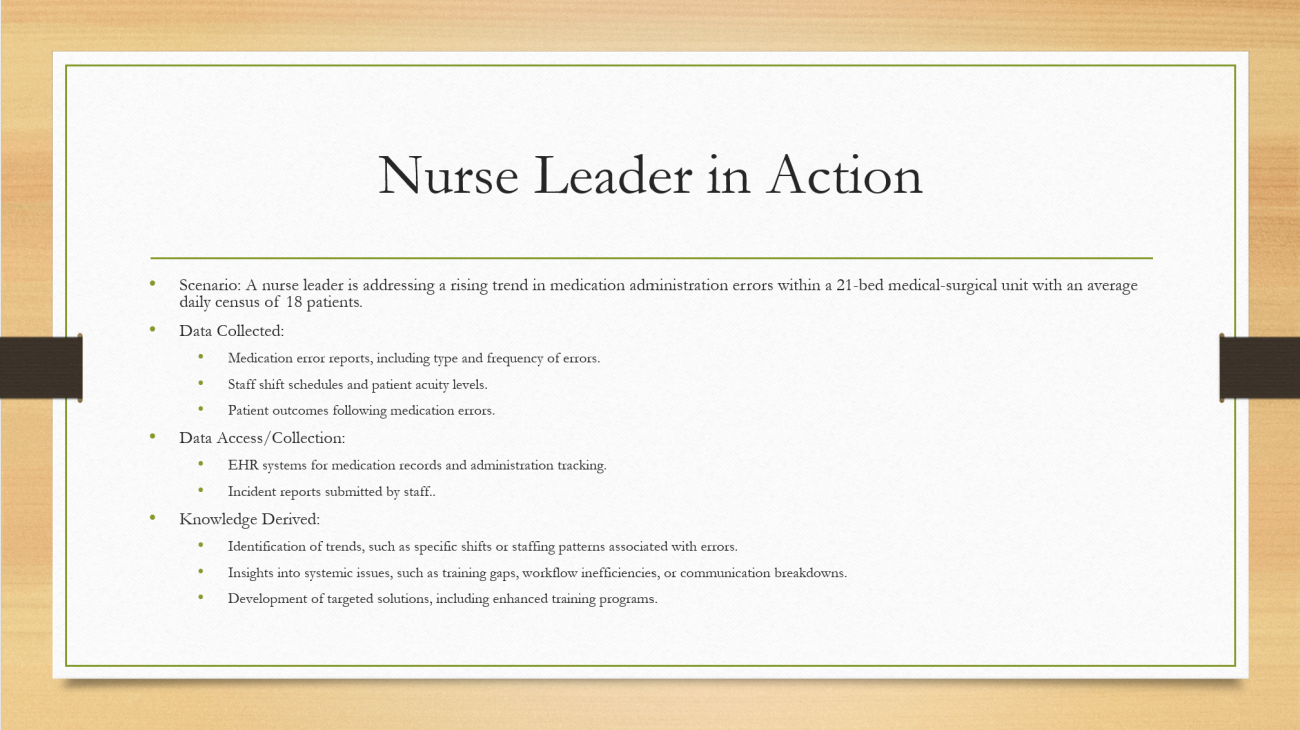
A nurse leader is addressing an increase in medication administration errors in a 21-bed medical-surgical unit with an average daily census of 18 patients. Errors, including incorrect dosages and missed medications, have risen over three months, possibly due to high-acuity patient loads, specific shifts, or staff performance. Data collection includes error reports, shift schedules, patient acuity levels, and EHR records. Feedback from staff and interdisciplinary teams helps identify trends and systemic issues like workflow inefficiencies or training gaps. Insights guide targeted interventions, such as improving staff-to-patient ratios, enhancing training programs, and implementing better communication tools to reduce errors and improve patient safety (McGonigle & Mastrian, 2022).
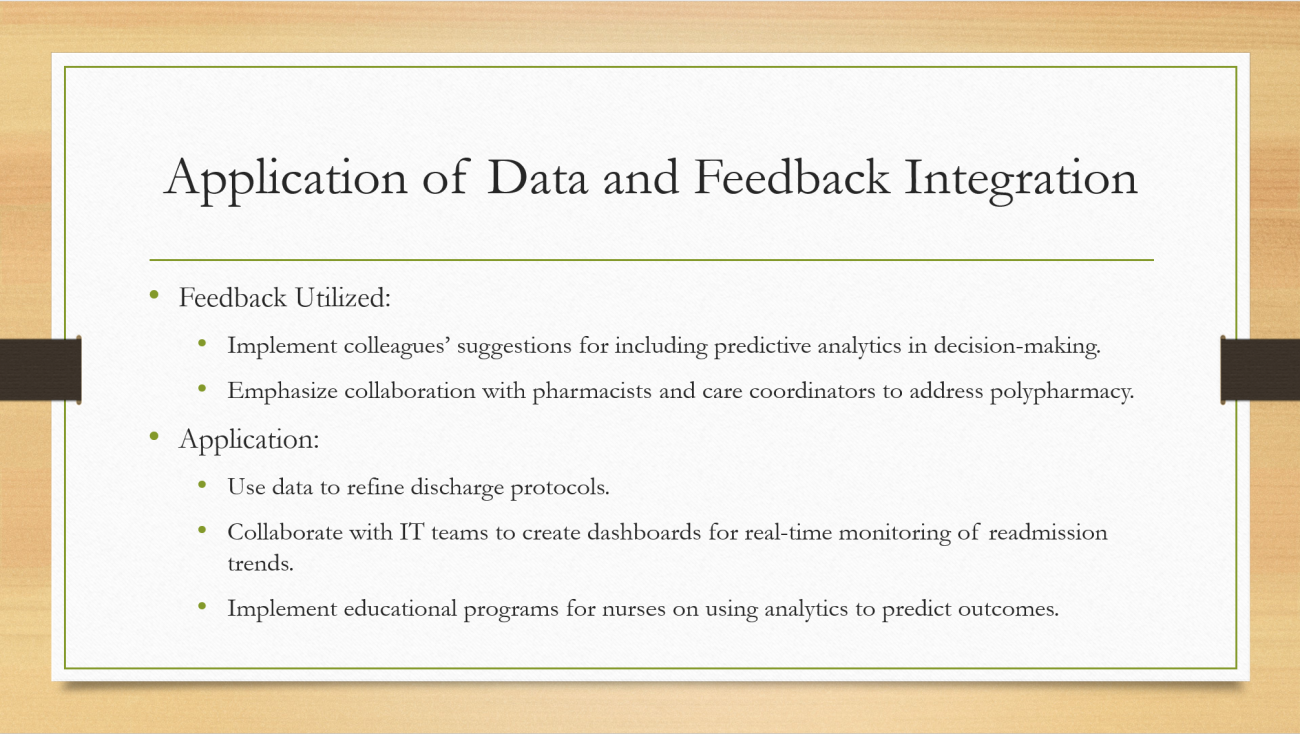
Nurse leaders refine discharge protocols based on real-time data, enabling better monitoring of patient trends and risks. Educational programs for nurses on data analytics and decision-making further support the implementation of evidence-based practices (Cummings et al., 2021). This approach underscores the importance of adaptability and collaboration in the nurse leader’s role as a knowledge worker.
References
- Cummings, G. G., Lee, S., Tate, K., Penconek, T., Micaroni, S. P., Paananen, T., & Chatterjee, G. E. (2021). The essentials of nursing leadership: A systematic review of factors and educational interventions influencing nursing leadership. International journal of nursing studies, 115, 103842. https://doi.org/10.1016/j.ijnurstu.2020.103842
- McGonigle, D., & Mastrian, K. G. (2022). Nursing informatics and the foundation of knowledge (5th ed.). Jones & Bartlett Learning.
- Khaksar, S. M. S., Chu, M. T., Rozario, S., & Slade, B. (2023). Knowledge-based dynamic capabilities and knowledge worker productivity in professional service firms the moderating role of organisational culture. Knowledge Management Research & Practice, 21(2), 241-258. https://doi.org/10.1080/14778238.2020.1794992
Place your order now for a similar assignment and get fast, cheap and best quality work written by our expert level assignment writers. Limited Offer: Use Coupon Code NEW30 to Get 30% OFF Your First Order
Limited Offer: Use Coupon Code NEW30 to Get 30% OFF Your First Order
FAQs
Weekly Resources
Reference: Drucker, P. (1959). The landmarks of tomorrow. New York, NY: HarperCollins Publishers
- McGonigle, D., & Mastrian, K. G. (2022). Nursing informatics and the foundation of knowledge (5th ed.). Jones & Bartlett Learning.
- Chapter 1, “Nursing Science and the Foundation of Knowledge” (pp. 7–17)
- Chapter 2, “Introduction to Information, Information Science, and Information Systems” (pp. 21–32)
- Chapter 3, “Computer Science and the Foundation of Knowledge Model” (pp. 35–64)
- Nagle, L., Sermeus, W., & Junger, A. (2017). Evolving Role of the Nursing Informatics SpecialistLinks to an external site.. In J. Murphy, W. Goosen, & P. Weber (Eds.), Forecasting Competencies for Nurses in the Future of Connected Health (212-221). Clifton, VA: IMIA and IOS Press. Retrieved from https://serval.unil.ch/resource/serval:BIB_4A0FEA56B8CB.P001/REF
- Sweeney, J. (2017). Healthcare informaticsLinks to an external site.. Online Journal of Nursing Informatics, 21 (1).
Rubric
| Develop a 4-slide PowerPoint presentation that addresses the following:
Explain the concept of a knowledge worker. Define and explain nursing informatics and highlight the role of a nurse leader as a knowledge worker. |
32 (32%) – 35 (35%)
The presentation clearly and accurately explains the concept of a knowledge worker. The presentation clearly and accurately defines and explains nursing informatics with a detailed explanation of the role of the nurse leader as a knowledge worker. Includes: 3 or more peer-reviewed sources and 2 or more course resources. |
28 (28%) – 31 (31%)
The presentation explains the concept of a knowledge worker. The presentation defines and explains nursing informatics with an explanation of the role of the nurse leader as a knowledge worker. Includes: 2 peer-reviewed sources and 2 course resources. |
25 (25%) – 27 (27%)
The presentation inaccurately or vaguely explains the concept of a knowledge worker. The presentation inaccurately or vaguely defines and explains nursing informatics with an inaccurate or vague explanation of the role of the nurse leader as a knowledge worker. Includes: 1 peer-reviewed sources and 1 course resources. |
0 (0%) – 24 (24%)
The presentation inaccurately and vaguely explains the concept of a knowledge worker or is missing. The presentation inaccurately and vaguely defines and explains nursing informatics with an inaccurate and vague explanation of the role of the nurse leader as a knowledge worker or is missing. Includes: 1 or fewer resources. |
|
| Develop a simple infographic to help explain these concepts. | 14 (14%) – 15 (15%)
The presentation provides an accurate and detailed infographic that helps explain the concepts related to the presentation. |
12 (12%) – 13 (13%)
The presentation provides an infographic that helps explain the concepts related to the presentation. |
11 (11%) – 11 (11%)
The presentation provides an infographic related to the concepts of the presentation that is inaccurate or vague. |
0 (0%) – 10 (10%)
The infographic provided in the presentation related to the concepts of the presentation is inaccurate and vague, or is missing. |
|
| Present the hypothetical scenario you originally shared in the Discussion Forum. Include your examination of the data you could use, how the data might be accessed/collected, and what knowledge might be derived from the data. Be sure to incorporate feedback received from your colleagues’ replies. | 32 (32%) – 35 (35%)
The presentation clearly and thoroughly includes the hypothetical scenario originally shared in the Discussion Forum, including a detailed and accurate examination of the data used, how the data might be accessed/collected, and the knowledge that could be derived from the data. |
28 (28%) – 31 (31%)
The presentation includes the hypothetical scenario originally shared in the Discussion Forum, including an accurate examination of the data used, how the data might be accessed/collected, and the knowledge that could be derived from the data. |
25 (25%) – 27 (27%)
The presentation includes the hypothetical scenario originally shared in the Discussion Forum, including an examination of the data used, how the data might be accessed/collected, and the knowledge that could be derived from the data that is vague or inaccurate. |
0 (0%) – 24 (24%)
The presentation includes the hypothetical scenario originally shared in the Discussion Forum, including an examination of the data used, how the data might be accessed/collected, and the knowledge that could be derived from the data that is vague and inaccurate, or is missing. |
|
| Written Expression and Formatting – Paragraph Development and Organization:
Paragraphs make clear points that support well developed ideas, flow logically, and demonstrate continuity of ideas. Sentences are carefully focused–neither long and rambling nor short and lacking substance. |
5 (5%) – 5 (5%)
Paragraphs and sentences follow writing standards for flow, continuity, and clarity. |
4 (4%) – 4 (4%)
Paragraphs and sentences follow writing standards for flow, continuity, and clarity 80% of the time. |
3.5 (3.5%) – 3.5 (3.5%)
Paragraphs and sentences follow writing standards for flow, continuity, and clarity 60%- 79% of the time. |
0 (0%) – 3 (3%)
Paragraphs and sentences follow writing standards for flow, continuity, and clarity < 60% of the time. |
|
| Written Expression and Formatting – English writing standards:
Correct grammar, mechanics, and proper punctuation |
5 (5%) – 5 (5%)
Uses correct grammar, spelling, and punctuation with no errors. |
4 (4%) – 4 (4%)
Contains a few (1-2) grammar, spelling, and punctuation errors. |
3.5 (3.5%) – 3.5 (3.5%)
Contains several (3-4) grammar, spelling, and punctuation errors. |
0 (0%) – 3 (3%)
Contains many (≥ 5) grammar, spelling, and punctuation errors that interfere with the reader’s understanding. |
|
| Written Expression and Formatting – The paper follows correct APA format for title page, headings, font, spacing, margins, indentations, page numbers, running head, parenthetical/in-text citations, and reference list. | 5 (5%) – 5 (5%)
Uses correct APA format with no errors. |
4 (4%) – 4 (4%)
Contains a few (1-2) APA format errors. |
3.5 (3.5%) – 3.5 (3.5%)
Contains several (3-4) APA format errors. |
0 (0%) – 3 (3%)
Contains many (≥ 5) APA format errors. |
|
| Total Points: 100 | |||||

Dan Palmer is a dedicated academic writing specialist with extensive experience supporting nursing students throughout their educational journey. Understanding the unique challenges faced by nursing students who balance demanding clinical rotations, family responsibilities, and rigorous coursework, Dan provides professional assignment assistance that helps students maintain academic excellence without compromising their other commitments.
With a comprehensive understanding of nursing curriculum requirements and academic standards, Dan delivers high-quality, thoroughly researched assignments that serve as valuable learning resources. His expertise spans various nursing disciplines, including clinical practice, healthcare ethics, patient care management, and evidence-based research.
Dan’s approach combines meticulous attention to detail with a commitment to timely delivery, ensuring that busy nursing students receive the support they need when they need it most. His professional assistance has helped countless nursing students successfully navigate their academic programs while maintaining their professional and personal responsibilities.
Committed to academic integrity and excellence, Dan Palmer continues to be a trusted resource for nursing students seeking reliable, professional assignment support.


